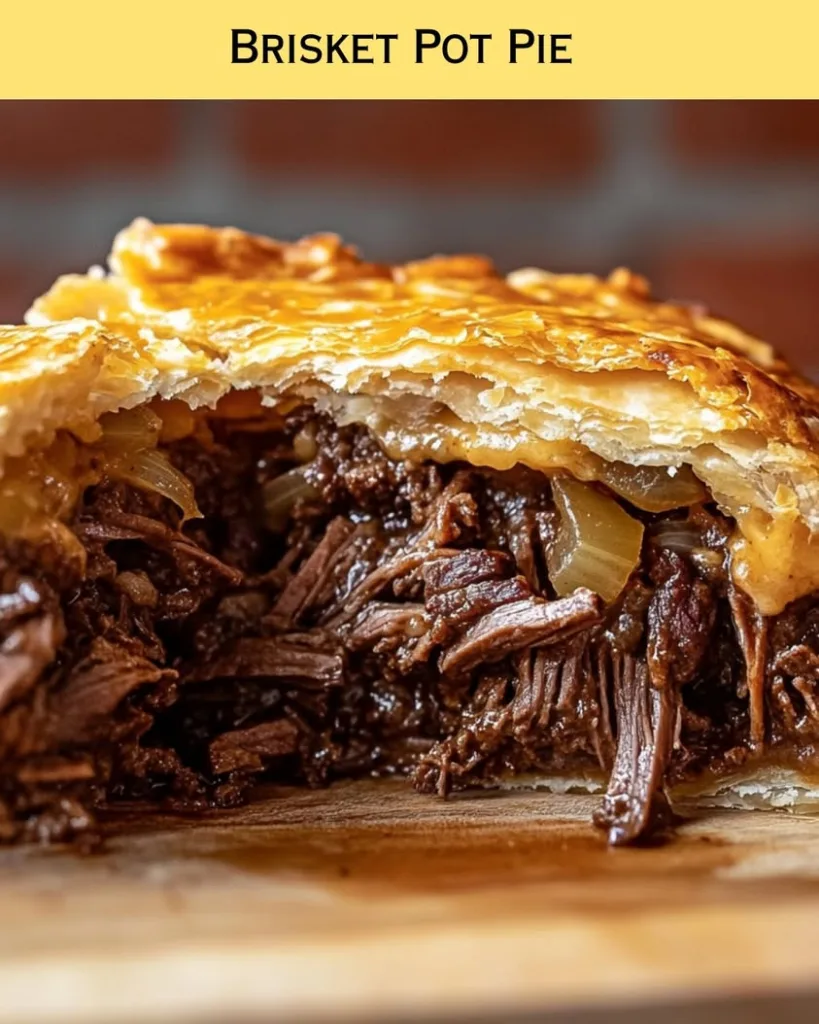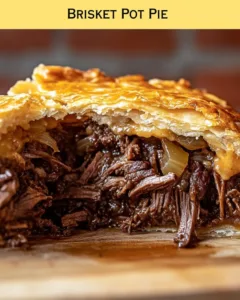Hearty Brisket Pot Pie: Comfort Food at Its Best
Brisket Pot Pie is the epitome of comfort food, combining tender brisket meat with rich, savory gravy encased in a flaky, golden crust. This dish marries the hearty flavors that evoke warmth and nostalgia, making it perfect for gatherings or family dinners on chilly evenings. The luscious filling, savory herbs, and a hint of wine create a complexity that dances on your taste buds, enticing even the pickiest of eaters. Plus, the act of slicing into a golden pie, revealing the bubbling filling, is sure to be a delightful spectacle that no one can resist.
This delicious brisket pot pie offers an appealing mix of textures, from the buttery crust to the melt-in-your-mouth tender meat. Each bite is filled with comforting notes of earthy vegetables and rich beef flavor, assuring each mouthful is satisfying. As the aroma wafts through your kitchen, with garlic, thyme, and savory beef filling the air, you can be sure that the anticipation will make you and your guests’ mouths water. The visual presentation of the pie, with its rustic edges and beautifully browned top, elevates any dining table and makes it a star dish for any meal occasion.
Quick Recipe Highlights
- Flavor Profile: This dish showcases a delightful blend of tender beef, subtly sweet carrots, savory onions, and aromatic thyme, all enveloped in a decadent gravy.
- Texture: The contrast of the flaky crust and the hearty, robust filling makes for a satisfying culinary experience that is both comforting and indulgent.
- Aroma: When baking, the combination of fresh herbs and roasting meat creates an inviting atmosphere that beckons everyone to the table.
- Visual Appeal: The golden-brown crust serves as a beautiful contrast to the rich, dark filling, making it a centerpiece worthy of any table.
- Skill Level Needed: With some basic cooking skills and a bit of patience, anyone can create this dish, making it a suitable challenge for both novice and experienced cooks.
- Special Equipment: A deep-dish pie plate or a Dutch oven is ideal for baking, ensuring even distribution of heat for a perfectly cooked pie.
Recipe Overview
- Difficulty Level: This brisket pot pie is categorized as medium difficulty primarily due to the time invested in preparing the filling and ensuring the crust is flaky and golden.
- Category: This recipe fits perfectly into the comfort food category, ideal for family meals or cozy gatherings.
- Cuisine: Borrowing influences from classic American cooking, this dish has roots in many cultures that embrace beef and hearty pastries.
- Cost: The approximate cost for this recipe is budget-friendly, as brisket and vegetables can be sourced economically, providing a delightful dish without breaking the bank.
- Season: Ideal for the cooler months of fall and winter, this dish embodies the cozy, hearty meals associated with the colder seasons.
- Occasion: Perfect for gatherings, holidays, or simply enhancing a weeknight dinner, this brisket pot pie is versatile for any occasion.
Why You’ll Love This Recipe
Brisket Pot Pie is the perfect marriage of flavor and comfort. The rich, savory taste of slow-cooked brisket creates a depth that is hard to rival. Each forkful delivers a delightful combination of flavors that meld perfectly, introducing a comforting warmth to every bite. Additionally, the textural contrast between the crispy crust and the moist filling contributes significantly to the overall satisfaction of the dish, making it a memorable meal.
One of the key advantages of this brisket pot pie recipe lies in its convenience. Preparation can be done in stages, allowing you to cook the brisket ahead of time and assemble the pie when you’re ready to bake it. This makes it an ideal solution for those busy weeknights or special occasions when you want to impress without overwhelming yourself in the kitchen. Plus, leftovers can be stored easily, making for another hassle-free meal.
Nutritionally, this brisket pot pie is a well-balanced choice. Packed with protein from the beef and nutrients from the vegetables, it serves as a satisfying option that can fuel your day. Plus, by controlling the ingredients in your pie, you can customize it to fit your dietary preferences and needs.
Sharing a hearty Brisket Pot Pie during gatherings enhances the social experience of dining. The delicious smell and presentation will draw people together, encouraging conversation and enjoyment, making it a perfect addition to any table. It fosters a feeling of warmth and hospitality that brings everyone together, leaving cherished memories.
Finally, from a cost perspective, this recipe is quite economical relative to the number of servings it provides. Using affordable cuts of brisket and simple vegetables, you can create a satisfying meal that feeds a crowd without straining your wallet.
Historical Background and Cultural Significance
The history of the pot pie is rich and varied, with origins tracing back to ancient civilizations who used a crust to encase meats and vegetables as a means of preservation and transport. The concept evolved through European culinary traditions, notably in England and France, before becoming a staple in American kitchens.
Culturally, pot pies represent comfort and home cooking. They evoke memories of family gatherings and traditional meals shared around the table. This dish resonates deeply, symbolizing warmth, love, and care, often prepared for special occasions or Sunday dinners.
Over time, the brisket pot pie has evolved from a simple dish into a culinary delight that showcases both regional flavors and personal touches. Many chefs and home cooks have added their twists to the traditional recipe, from incorporating different spices to utilizing robust stock variations, reflecting the evolving culinary landscape.
Regional adaptations highlight the versatility of the brisket pot pie. From Southern-style preparation featuring biscuits instead of a traditional crust to the inclusion of local vegetables and herbs, the pot pie has become a canvas for showcasing local produce and culinary influences.
Ingredient Deep Dive
Brisket: This flavorful cut of beef is known for its tenderization when slow-cooked. Rich in collagen, brisket becomes succulent and melt-in-your-mouth tender, ideal for a comforting pot pie. When selecting brisket, look for marbling that indicates flavor, and store it in the fridge for up to three days or freeze for longer-term use. If brisket isn’t available, chuck roast or shredded pork can work as suitable substitutes.
Vegetables: Commonly, carrots, potatoes, and onions are used in this brisket pot pie recipe. Each adds depth of flavor and nutrition. The sweet earthiness of carrots balances the rich meat, while potatoes provide heartiness. Choose fresh, firm vegetables for best results, and store them in a cool, dark place. If substitutions are necessary, parsnips or peas could lend a new touch.
Herbs and Spices: Fresh herbs like thyme and rosemary enhance the flavor profile of the brisket pot pie remarkably. These aromatic additions not only elevate the taste but also provide nutritional benefits. When using herbs, opt for fresh as much as possible, enhancing the dish’s freshness. They can be stored in the refrigerator for up to a week or dried for longer shelf life.
Common Mistakes to Avoid
- Overcooking the brisket can lead to tough, chewy meat instead of the desired tenderness. Slow cooking is key to breaking down collagen effectively.
- Using a flimsy pie crust can result in a soggy bottom. Always use a high-quality, well-chilled pie crust for better structure.
- Overfilling the pie with filling can cause it to overflow during baking. It’s important to leave some space between the filling and the crust.
- Not allowing the filling to cool before assembly can lead to a soggy crust as the steam escapes during baking.
- Skipping the egg wash can lead to a dull crust. An egg wash provides a beautiful golden color that enhances visual appeal.
- Neglecting to properly season the filling can result in bland flavors. Take the time to taste and adjust seasonings accordingly.
- Baking at too high a temperature may burn the crust before the inside is fully cooked. Stick to recommended temperatures for even cooking.
- Removing the pie from the oven too soon can create a filling that isn’t set. Be sure to test for doneness properly before taking it out.
- Improperly storing leftovers can lead to spoilage. Ensure proper cooling and airtight storage to maintain freshness.
- Not letting the pie rest before slicing can cause the filling to spill out. Allow it to rest for at least 10-15 minutes for best results.
Essential Techniques
Slow Cooking: The slow-cooking method is crucial for maximizing flavor and tenderness in brisket. By using low heat over an extended period, you allow the meat to become succulent. Take care to sear the brisket prior to slow cooking to lock in flavor, and set a timer to avoid overcooking.
Making a Flaky Crust: Achieving a flaky pie crust is all about the temperature of the ingredients and careful handling. Keep your fat and water cold, and avoid overworking the dough. Look for visuals of the dough forming small flakes after rolling and layering, as this indicates proper incorporation.
Layering Flavors: Building a base for your pot pie involves browning the meat and cooking the vegetables to release their natural sweetness. Pay attention to the color and texture of ingredients, as browning indicates flavor development. Deglazing the pan afterward captures all those fond bits for ultimate flavor in the filling.
Assembling the Pie: Proper assembly of the pot pie is essential to ensure even cooking and avoid leaks. Lay the bottom crust evenly on your pie plate before filling. Use a fork to crimp the edges, ensuring it seals well. Visual cues, such as a smooth surface without cracks, are signs of proper assembly.
Pro Tips for Perfect Brisket Pot Pie
When preparing your brisket pot pie, always season generously. Since brisket is fatty, it benefits from robust seasoning to penetrate the meat effectively.
Allow your filling to cool completely before assembling the pie. This prevents the heat from cooking the crust prematurely and ensures a flaky texture.
To enhance the depth of flavor, consider using beef broth instead of water when preparing your filling. This adds an additional layer of richness.
Experiment with the addition of mushrooms for a more earthy flavor. They complement the brisket well and add a satisfying umami component.
Don’t shy away from garnishing your dish with fresh herbs before serving. A sprinkle of fresh thyme or parsley can elevate the final presentation and flavor dramatically.
Let your brisket pot pie rest for at least 15 minutes before slicing. This helps the filling to set and prevents a messy slice.
Use a combination of different types of potatoes. Mixing russet with Yukon gold creates layers of texture within your filling that adds interest.
Finally, wrap any leftover pie in foil properly, ensuring it is well sealed to maintain freshness and flavor during storage.
Variations and Adaptations
For regional variations, try adding local ingredients like sweet potatoes for a Southern twist or incorporating Cajun spices for a bit of heat. Seasonal adaptations can feature butternut squash or wild mushrooms in the fall, while providing a fresh pea and asparagus filling in the spring.
For dietary modifications, using shredded jackfruit instead of brisket can create a vegan version, while gluten-free crust options are readily available for those with gluten sensitivities.
Experiment with flavor variations by introducing different spices, such as smoked paprika or cumin, to jazz up the traditional brisket filling. Texture modifications can include adding a layer of cheese on top of the filling for a creamy touch, or including roasted nuts for crunch.
Lastly, consider presentation alternatives like individual pot pies baked in ramekins or using puff pastry instead of a traditional pie crust for a modern twist.
Serving and Presentation Guide
For an elegant touch, serve your brisket pot pie on large platters, allowing guests to help themselves. To enhance the presentation, use a serrated knife to create clean slices that showcase the exquisite filling and crust.
Garnishing ideas include a sprinkle of freshly chopped parsley or thyme, and serving alongside a simple salad to balance the richness. Incorporating traditional accompaniments like buttery mashed potatoes can make the dish even more comforting.
Modern serving suggestions might involve pairing slices with a tangy slaw for a contrasting crunch, or a dollop of sour cream for added creaminess. Remember to serve the pot pie warm, ensuring a cozy experience.
Portion control is essential; a typical serving would be around one-eighth of the pie. Using a pizza cutter can help achieve neat slices without disturbing the filling.
Wine and Beverage Pairing
For optimal pairing, consider a medium-bodied red wine like Cabernet Sauvignon, which complements the richness of the brisket beautifully. Alternatively, a robust Shiraz or Malbec also enhances the flavors without overpowering them.
For non-alcoholic alternatives, try pairing the dish with a hearty, homemade iced tea or a refreshing sparkling water with a slice of lemon for a palate cleanser.
If you enjoy coffee, a dark roast served black can enhance the flavors of your meal. Use caution with temperature; ensure any coffee or tea is served hot yet not boiling to maintain an enjoyable drinking experience.
Storage and Shelf Life
To store leftovers, ensure the brisket pot pie is cooled completely before placing it in the fridge. Use an airtight container or wrap it tightly in plastic wrap or aluminum foil to keep it fresh for up to three days.
For longer storage, consider freezing individual portions for later meals. Make sure to use freezer-safe containers, and label with dates to track freshness.
Signs of spoilage include an off odor or moisture indicating that the pie has begun to dry out. For reheating, place in an oven at a low temperature to retain its flaky crust, typically around 350°F for 25-30 minutes.
When freezing, also think about reheating tips—allow the pie to defrost in the fridge overnight before reheating to ensure even cooking.
Brisket pot pie can be frozen for up to three months without compromising its taste.
Make Ahead Strategies
Utilizing a prep timeline can help streamline the process of making your brisket pot pie. Cook the brisket up to two days in advance, and store it in the fridge to let the flavors deepen.
When preparing the filling, consider chopping vegetables one day ahead. Keeping them stored in an airtight container will keep them fresh.
Quality remains key; however, take extra care to avoid soggy crusts. Assembling the pie can be completed the day before and stored in the fridge, just remember to add an extra few minutes to the baking time.
While keeping quality in mind, aim to assemble and bake your pie on the day of serving whenever possible to ensure maximum freshness.
Finally, feel free to add fresh herbs or other components just before serving to maintain texture and flavor.
Scaling Instructions
Scaling your brisket pot pie recipe is straightforward. To halve the recipe, simply adjust the ingredients accordingly.
When doubling or tripling, ensure that your baking dish is large enough to accommodate the increased volume, or consider making two smaller pies instead.
For equipment adjustments, larger pots or dishes may be necessary, so check your kitchen supplies prior to starting the recipe.
Timing modifications are crucial; larger portions may require an increase in cooking time. To ensure even cooking, consider using a thermometer to gauge when the internal filling reaches the proper temperature.
Be mindful of storage considerations as well—larger portions might need separate storing solutions to keep the pie fresh.
Nutritional Deep Dive
The brisket pot pie is packed with macros, featuring core elements such as protein from the brisket, carbs from the potatoes, and fiber from the vegetables.
Micronutrient analysis reveals that the inclusion of carrots increases vitamin A levels, while herbs contribute antioxidants that can benefit overall health.
From a health standpoint, serving this meal alongside a salad can balance nutrient intake and provide a more holistic meal experience.
Portion analysis encourages moderation; a slice can provide a hearty meal but should be balanced with lighter meals throughout the day for overall wellness.
If weight management is a concern, consider utilizing leaner cuts of brisket or reducing the portion of crust to ensure a well-rounded, hearty yet moderate meal.
Dietary Adaptations
For a gluten-free version, utilize a gluten-free pie crust made of almond flour or rice flour, ensuring everyone at the table can enjoy it.
Those requiring a dairy-free option can substitute traditional butter in the crust with coconut oil or vegan butter to keep the recipe creamy without using dairy.
A vegan adaptation can be achieved by replacing brisket with lentils or jackfruit, ensuring to replicate the savory gravy for completeness.
Low-carb dieters might swap out the crust entirely or utilize cauliflower crust for a low-carb alternative.
For a healthier approach, a Paleo variation can leverage all-natural ingredients like almond flour without artificial additives or refined sugars.
Maintaining awareness of dietary preferences, consider also including low-FODMAP adaptations for those with dietary restrictions around certain fibers and carbohydrates.
Troubleshooting Guide
If your brisket pot pie texture is off, check for the right cooking duration, as undercooked brisket might yield a chewy result while overcooked can be dry.
For flavor balance issues, consider whether you properly layered flavors during cooking. Adding more herbs or spices can enhance the overall taste effectively.
If you’re experiencing temperature problems, ensure your oven is correctly calibrated; an incorrect temperature can lead to uneven cooking.
In case of equipment challenges, ensure that necessary tools were used effectively, as a heavy-bottomed pan aids in distributing heat properly.
For ingredient substitutions, familiarize yourself with flavor similarities to avoid unexpected taste shifts and encourage thorough experimentation.
Finally, pay attention to timing concerns; allow adequate periods for resting after cooking to ensure the filling sets, leading to cleaner slices and a better presentation.
Recipe Success Stories
Community feedback has often highlighted the richness and comfort this recipe brings, consistently reported as a crowd-pleaser.
Many shared variations incorporate unique spices that reflect personal taste, leading to delightful adaptations that stay true to the original dish while adding personalized touches.
Adaptation stories have included substituting different meats or vegetables based on availability, showcasing the recipe’s versatility through its deliciousness regardless of changes.
Photography tips from readers emphasize the importance of lighting and angles to truly capture the magnificence of the finished pot pie, encouraging creativity in presentation.
Overall, success stories remind us that food not only nourishes but also provides connections across kitchens and dining tables.
Frequently Asked Questions
How long will leftovers last in the fridge? Leftovers can be kept in the refrigerator for about three days when stored properly in an airtight container.
Can I make this dish ahead of time? Yes, you can prepare the brisket and filling in advance. Assemble and bake the pie on the day of serving for the best results.
What can I use instead of brisket? If brisket isn’t available, other cuts like chuck roast or shredded chicken are great alternatives that can maintain similar flavors.
How do I know when the filling is done? The filling should be hot and bubbling, which indicates it’s achieved the desired doneness. Use a thermometer if unsure, targeting 165°F.
Is this recipe suitable for meal prepping? Absolutely! The brisket pot pie can be made in advance and easily reheated, making it a convenience for meal prep enthusiasts.
What side dishes pair well with pot pie? A fresh salad or roasted vegetables work beautifully with pot pie, providing a balance to the rich dish.
Can I use store-bought pie crust? Yes, using a store-bought pie crust is a convenient option that saves time without compromising flavor.
Can I use different vegetables in the filling? Absolutely! Feel free to experiment with your favorite veggies or whatever is in season.
What’s the best way to reheat leftover pot pie? Reheat in the oven at 350°F for about 25 minutes or until thoroughly warmed through for the best results.
Additional Resources
If you loved this brisket pot pie recipe, you’ll also enjoy similar comforting dishes like chicken pot pie or shepherd’s pie. For techniques, consider exploring guides on making the perfect crust or slow-cooking.
For ingredient information, familiarize yourself with different cuts of beef and seasonal vegetables that enhance the quality of your pot pie. Lastly, check out equipment recommendations to ensure you have the right tools for a seamless cooking experience.
Join the Conversation
We’d love to hear from you! Share your photos of your homemade brisket pot pie on social media, and don’t hesitate to provide feedback on your cooking experiences.
Your recipe variations are valuable, and your suggestions might inspire others to explore new culinary avenues. Engage with our community, partake in discussions, and enjoy your cooking adventures!
The Recipe
Brisket Pot Pie
Serves: 6 servings
Prep Time: 30 mins
Cook Time: 2 hours
Total Time: 2.5 hours
Kitchen Equipment Needed
- Deep-dish pie plate
- Large Dutch oven
- Cutting board
- Chef’s knife
Ingredients
- 2 lbs brisket, cubed
- 1 large onion, chopped
- 2 carrots, diced
- 2 potatoes, diced
- 3 cloves garlic, minced
- 1 tsp dried thyme
- 2 cups beef broth
- 1 cup red wine (optional)
- 1 package of pie crust (homemade or store-bought)
- 1 egg (for egg wash)
- Salt and pepper to taste
Directions
- In a large Dutch oven, brown the cubed brisket on all sides over medium-high heat. Remove and set aside.
- Add onion and garlic, sauté until translucent, then stir in carrots and potatoes for about 5 minutes.
- Return the brisket to the pot, add herbs, broth, and wine, bring to a boil before reducing heat to low.
- Cover and simmer for about 1.5 hours, or until brisket is tender.
- Preheat oven to 400°F (200°C). Roll out the pie crust and fit it into the deep-dish pie plate.
- Pour the cooled filling into the prepared crust, cover with another crust, then crimp edges to seal.
- Cut slits in the top crust for steam to escape and brush with an egg wash.
- Bake for 30-35 minutes or until the crust is golden brown and filling is bubbling.
- Allow to rest for 15 minutes before serving.
Recipe Notes
- You can make the filling a day in advance and assemble the pie just before baking.
- Consider adding mushrooms for added depth and earthy flavor.
- Substitutions for the brisket can include ground beef or chicken for lighter options.










